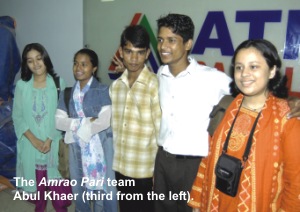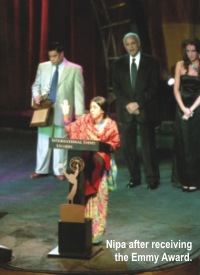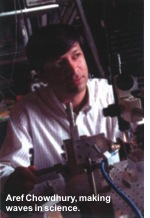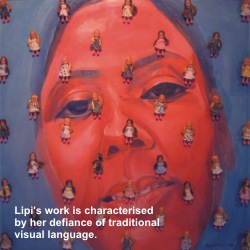|
Cover
Story
Achievers
of 2004
At
a time when it has become difficult to count our blessings
and have a positive outlook on life, it is crucial for a nation
to look for causes to celebrate. As we end 2004, SWM takes
a look into this eventful year and selects a number of achievers
who have shown that talent combined with determination and
hard work can bring about amazing results. These individuals
represent the brand of people who have managed to keep the
flicker of hope for our country alive and flaming.
Amrao
Pari
Abul Khaer and the Emmy
Best known for its political instability and natural disasters,
Bangladesh has surprised the world when "Amrao Pari"
(We, too, Can), a documentary directed, shot and edited by
18 Bangladeshi teenagers has won the 32nd Academy of Television
Arts and Science (EMMY) Awards.
 Abul
Khaer, the protagonist of the documentary, is himself a hero
in real life. On an early July morning in 1996, the nine-year-old
stopped a passenger train that was approaching a disjointed
track at the Boaljhuri Railway Bridge. Abul
Khaer, the protagonist of the documentary, is himself a hero
in real life. On an early July morning in 1996, the nine-year-old
stopped a passenger train that was approaching a disjointed
track at the Boaljhuri Railway Bridge.
"At
that time I had 20 ducks and ducklings, which laid around
18 eggs a day. My father was a day labourer and apart from
him, these eggs were the only source of income for us. Every
day I woke up early in the morning to collect snails and oysters
for the ducks," Khaer recalls. While browsing through
stones on the rail track, near the Toraghar crossing, Khaer
discovered a part of the rail line disjointed.
"I
tried to reunite the tracks by hand, but failed," he
continues, "Then I realised that the Chittagong bound
Antanagar Meghna was going to come within 10 minutes or so."
He shouted for help, but no one came.
Khaer
knew he would be able to stop Antanagar Meghna if he could
wave anything red to the driver. The child, who would later
drop out from school because of sheer poverty, ran home and
brought his aunt's red petticoat. When he went up the track,
waving the red cloth, the train was only 200 metres away.
The train,
however, stopped. "But the driver was extremely furious,"
Khaer recalls. "He yelled at me and asked why I was waving
a red cloth at the train," Khaer smiles, and looks at
the young team that recreated the whole incident on film to
win this year's prestigious EMMY.
Half
the 18 teenagers of the EMMY-winning group were already household
names by their participation in ETV's Muktokhobor.
When the television channel went off air, these children,
along with the programme's producer Rowshon Ara Rukhsana Sirkar
Nipa, decided to join ATN.
"Nipa apa called and told us not to quit filmmaking,"
Robiul Islam Raju, who went to Boaljhuri, Chandpur, for shooting
says. In fact, Mahfujur Rahman, ATN-Bangla's chairperson,
grabbed the idea when Nipa submitted her project proposal.
"He
immediately approved it and named it Amra Korbo Joy,"
Nipa says, "Eighteen children, half of whom are underprivileged,
work with this programme. And our motto is, 'By children,
for children, to everyone'."
Broadcast
at 6:30 every Friday evening the programme has become an instant
hit among the channel's young audience. The children get a
monthly allowance of Tk 3,000 each.
"It
was Tk 1500 in ETV. Then again we worked only seven days a
month at that time. Now we work two weeks in a month,"
Fateema Akhtar, another cub reporter and a student of Mirpur
Technical College, says. "Every month I save something
from my allowance and send it to my parents in the village,"
she continues.
When UNICEF
wanted the team to make a documentary for the World Child
Broadcasting Day, the group decided to focus on Abul Khaer.
Two members of the team, along with their producer and two
other adult members went to Khaer's home in Hajiganj to re-enact
the incident.
Guided
by Nipa and other adult members of the ATN staff, the children
did most of the direction, cinematography and editing. "We
operated the camera and sat with the editor. We took all the
editing decision by ourselves," recalls Khairul Amin
Nahin, one of the cinematographers of the team. Nahin, a student
of Dhaka College, was not in Muktokhobor; he joined
Amra Korbo Joy after undergoing a one-month training
course.
 When
it was made, Rezwanul Haque of UNICEF Bangladesh advised the
team to send it to International Children Day of Broadcast
(ICDB). On 14 October this year, the film was nominated for
EMMY-UNICEF Award. The other three documentaries that got
nominations in this category were produced by Lao National
Television, Walt Disney China and National Television Kenya. When
it was made, Rezwanul Haque of UNICEF Bangladesh advised the
team to send it to International Children Day of Broadcast
(ICDB). On 14 October this year, the film was nominated for
EMMY-UNICEF Award. The other three documentaries that got
nominations in this category were produced by Lao National
Television, Walt Disney China and National Television Kenya.
The award
was declared on November 22. In the other nine categories,
BBC and Channel Four grabbed the most awards and MTV got a
special award for its HIV/AIDS campaign.
Though
the documentary is littered with editing and directional flaws,
critics believe it was the film's humane touch that has won
it the award.
Things,
however, had remained unchanged very little for Abul Khaer
till the making of Amrao Pari. In 1996, to recognise
his bravery, the government gave Abul Khaer a lump-sum amount
of Tk 2,500. Though the Chandpur District Administration had
promised to give his family an abandoned acre of government
land, it has never been kept. The boy had to quit study and
all the duck and ducklings the family had raised died too.
When
Amra Korbo Joy team came back to Dhaka they told
the ATN authorities about Khaer's plight and the channel employed
him first as an office peon this year, then as an assistant
cameraman.
-
Ahmede Hussain
Aref
Chowdhury (Rubel)
A Young Innovator
For Aref Chowdhury (Rubel), three years as a researcher at
Bell Labs was not just another job, it was a life-altering
experience through which he earned acclamation within the
scientific world. On September 20, 2004, MIT's magazine, Technology
Review named Chowdhury one of the top 100 young innovators
of the world. Innovators under thirty-five were nominated
for their help in transforming the nature of technology and
business in industries such as biotechnology, computing and
nanotechnology.
 Chowdhury,
along with his 99 other counterparts was honoured on September
29-30 at Technology Review's 'Emerging Technologies' conference
in Cambridge, Massachusetts in the United States, in which
the subject of discussions was on the technological innovations
that have the potential to fuel new economic growth and change. Chowdhury,
along with his 99 other counterparts was honoured on September
29-30 at Technology Review's 'Emerging Technologies' conference
in Cambridge, Massachusetts in the United States, in which
the subject of discussions was on the technological innovations
that have the potential to fuel new economic growth and change.
Chowdhury
has a bachelor's degree in Engineering, with Honours in Electrical
Engineering and Applied Mathematics and Statistics from the
State University of New York, Stonybrook, and a Ph.D in Electrical
Engineering from the University of Wisconsin-Madison. While
he was there, Technology Review recognised Chowdhury's work
on nonlinear photonic crystals, where he designed and fabricated
nonlinear photonic crystals that could be used to switch date
between individual wavelengths of light when routing information
optically.
Bell Labs
is the Research and Development division of Lucent Technologies,
which designs and delivers the systems, services and software
that drive next-generation communications networks. It has
played a pivotal role in inventing and perfecting key communications
technologies, including transistors, digital networking and
signal processing, lasers and fiber-optic communications systems,
communications satellites, cellular telephony, electronic
switching of calls, touch-tone dialing and modems.
Chowdhury's
field is nonlinear optics and biochemical detection research.
On the prestigious title he has been given, Chowdhury says,
"It is a great honour to be recognised, but a lot of
the credit goes to my research colleagues. I feel very lucky
to work with world-class scientists here at Bell Labs on research
that can positively impact Lucent and beyond."
Director
of Quantum Information and Optics research at Bell Labs, Dick
Slusher has some thoughts to share, "Aref is representative
of the calibre of a scientist hard at work on problem solving,
significant research challenges here at Bell Labs. He joins
a great group of Bell Labs alumni that have won this award
in previous years and we applaud his accomplishments."
Aref
Chowdhury's accomplishments serve as a source of inspiration
for not only young innovators, but also young Bangladeshis
everywhere. He is the living proof that hard work and determination
eventually helps one win the race. His work is not only praised
by his immediate colleagues and co-workers, but has been recognized
internationally as a means to change and transform the future
of science and technology, thereby impacting the world we
live in positively.
-Srabonti
Narmeen Ali
 Self-Analysis Self-Analysis
Lipi's Visual Solution
Projecting one's childhood on the canvas is something of a
challenge for any artist, as the murky hue of nostalgia always
plays havoc with the artistic verve by making it too moody
or glum. For Tayeba Begum Lipi, childhood memories serve to
express the usual visual verve, as she brings them on to put
forward a statement. Childhood, in her work, gets a new lease
on life and meets the artist's current self-portrait. This
union of the present and the past has fetched Lipi the Grand
Prize at the 11th Asian Biennale of Bangladesh Shilpakala
Academy in January 2004.
Lipi
says her entry into the arts was by accident. Tayeba, after
passing out from college in 1986, came to Dhaka to seek admission
in the journalism department of the Dhaka University. The
moment she entered the walled area of the Institute of Fine
Arts, she was taken by the beauty of its setting and environment.
Disregarding her parents' advice and shunning her art student
brother's outrage, she sat for the entrance examination and
was allowed admission.
In
1991, when she was introduced to oil colour in her drawing
and painting department her enthusiasm was boosted. "At
this point I realised that I would certainly become a painter,"
exclaims Tayeba remembering her struggle in the early years
in the Institute of Fine Arts while trying to find a foothold
in the domain of art.
Around
1995, she got a chance to attend an artist camp in Nepal.
There she met young artists from the subcontinent, and it
was at this time that she was introduced to all the different
aspects of art. She did a lot of landscapes there, which contributed
to her development in handling oil.
As
she gradually woke up to the fact that art is not merely confined
to the boundary of the frame of a canvas, she felt liberated.
Art as an easel painting had been her fixation, but in Nepal
her ideas were given a thorough shake, when she had seen young
artists experimenting with space and objects defying traditional
visual languages. She felt at home with the new mode that
tends to extend the border of the very concept of art.
She
came back to Dhaka with her enthusiasm enhanced and confidence
reinforced. The change that affected her translated into her
paintings; she started to put falling and contorted female
figures against a vegetation-rich landscape.
Though
her paintings at that time exteriorised a feeling of outright
confidence, they were markedly different from what she would
later embark on. In the second part of her Masters of Fine
Arts, she had fully realised her goals: it was to formulate
a socially relevant language of art. To fulfil that ambition
she juxtaposed static female figures that resembled mannequins.
She had in mind the emancipation of women. So, it was fashion
and trend that became the subject that she poked fun at. Her
female forms were depicted frozen alongside the paraphernalia
of the dorjee, (tailor) to suggest conformity.
With
the language of art, she herself became a nonconformist. In
the new millennium, her art boldly tackled ideas that tossed
her into the limelight. She started to use her self-portrait,
and combined realistically executed paintings with installed
objects, human dummies and so on to formulate a voice of socio-political
significance.
 Lipi
likes to believe that her sojourn in Ireland had created opportunities
she otherwise might have overlooked. She was awarded residency
for three months. "My ideas reached maturity in Ireland
as I was exposed to a lot of stimulation and I also had the
time to generate ideas of my own," says Tayeba. In a
show by Lipi and her artist husband in 2002, Tayeba's Toy
Watching Toys was all the rage, where her three big realistic
portraits were presented vis-a-vis burkha-clad dummies
fashioned after herself. In the last solo that she called
"Even The Walls Have Ears", she mixed together video
installation with two-dimensional images. Lipi
likes to believe that her sojourn in Ireland had created opportunities
she otherwise might have overlooked. She was awarded residency
for three months. "My ideas reached maturity in Ireland
as I was exposed to a lot of stimulation and I also had the
time to generate ideas of my own," says Tayeba. In a
show by Lipi and her artist husband in 2002, Tayeba's Toy
Watching Toys was all the rage, where her three big realistic
portraits were presented vis-a-vis burkha-clad dummies
fashioned after herself. In the last solo that she called
"Even The Walls Have Ears", she mixed together video
installation with two-dimensional images.
Tayeba
had to struggle in real life to overcome financial snags.
Since the beginning, she and her husband took up art as their
only pursuit, now the two shepherd an organisation named Britto.
At present she remains at the helm of this artists' trust
as its director. As for her fight to overcome personal obstacles,
it is intrinsically bound with her struggle to find an artistic
language of her own. Currently she has been awarded a year
round Scholarship from the Artist Aminul Islam Trust. Throughout
her journey she carries all the emotional baggage that make
up her personality. Perhaps that is how she so easily confronts
her self-portraits in the form of her work.
-Mustafa
Zaman
Continued
to Page 2
Copyright
(R) thedailystar.net 2004
|
